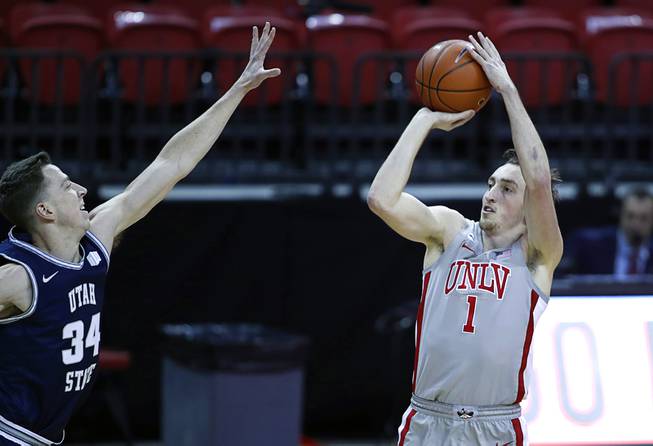
UNLV Rebels forward Moses Wood (1) puts up a shot against Utah State Aggies forward Justin Bean (34) at the Thomas & Mack Center Wednesday, Jan. 27, 2021.
Tuesday, Feb. 16, 2021 | 2 a.m.
Related content
Things are not going well for UNLV basketball. With four games remaining on the regular-season schedule T.J. Otzelberger’s squad is 8-11 overall and 5-7 in the Mountain West, and they have consistently come up short in close games against good teams, including a two-game sweep at the hands of Boise State over the weekend.
On the surface the trends do not look promising. The same could have been said about last year’s team, however, and then UNLV closed the season on a five-game winning streak and appeared poised to make a run in the conference tournament if not for a late season-ending injury to point guard Elijah Mitrou-Long.
That obvious comparison has loomed over the team all season as Otzelberger has struggled to bring together a roster full of disparate skill sets. If he whipped last year’s team into shape at the end, he should be able to do it again, right?
Well, this season is not last season. The roster is different, the rest of the league is different, and the issues facing the team are different.
Still, might the solution be the same?
At the risk of magical thinking, the answer to UNLV’s problems might be simple: Go small.
That may sound odd, because isn’t UNLV already playing relatively small? Yes, 6-foot-11 center Mbacke Diong is the only true big man in the rotation, but there are some advanced metrics that suggest UNLV could benefit from downsizing even further.
Among UNLV’s 11 most-used lineups this season, the group that has performed the best is one that features three guards, two small forwards and no big men.
The five-man combination of Bryce Hamilton, David Jenkins, Caleb Grill, Devin Tillis and Moses Wood has logged exactly 17 minutes together, and in that time they’ve outscored the opposition, 35-26.
Much of that lineup’s potency comes from its offensive efficiency; they’ve posted an offensive rating of 109.3, by far the best mark among UNLV’s most common combinations. It’s the byproduct of getting the team’s three best shooters on the floor at the same time (Grill, Wood and Jenkins, who have combined to hit 38.6 percent from 3-point range this year) along with Hamilton’s slashing/scoring ability and Tillis’ ability to pass and draw fouls out of the post. Without a true point guard to run things, Hamilton and Tillis combine to give UNLV just enough playmaking skills to create open looks.
They’ve also held their own on the defensive end, posting a defensive rating of 81.2. That gives the Jenkins-Grill-Hamilton-Tillis-Wood lineup a net rating of +28.1, which is far and away the best of any of the 99 different lineup combinations Otzelberger has tried this season, albeit in a very small sample size.
That particular lineup hasn’t gained much traction yet; Otzelberger didn’t use it at all in UNLV’s last-second loss at Boise State on Saturday, and they played just 4:39 combined in the two games prior to that. And Otzelberger is right to resist going away from Diong, who has given UNLV steady play in the middle this year; the senior still appears in all four of the team’s other positive-efficiency lineups.
Going small with Tillis and Wood in the frontcourt poses some clear issues for UNLV, namely a lack of rim protection and the possibility that they'll get killed on the boards. But if they can create open looks, execute Otzelberger's pack-line defense and turn games into 3-point shooting contests, essentially leveling the field against better teams, UNLV's snipers might be able to come out on top.
UNLV’s final four games are against San Jose State and Fresno State (combined Mountain West record of 10-18), so those 160 minutes should serve as an opportunity for Otzelberger to tinker and prepare for one last push in the conference tournament. There’s a chance we’ll see the scarlet and gray go small in a last-ditch attempt to salvage the season.
Mike Grimala can be reached at 702-948-7844 or [email protected]. Follow Mike on Twitter at twitter.com/mikegrimala.

Join the Discussion:
Check this out for a full explanation of our conversion to the LiveFyre commenting system and instructions on how to sign up for an account.
Full comments policy